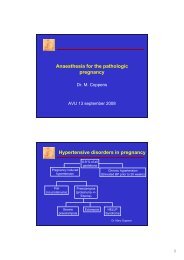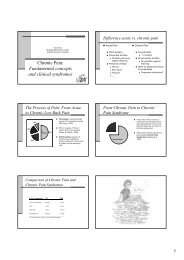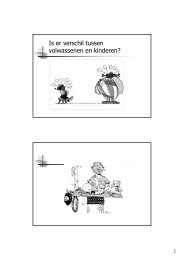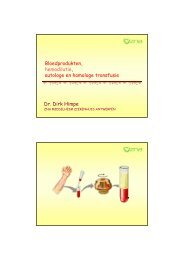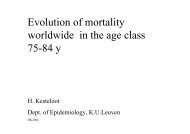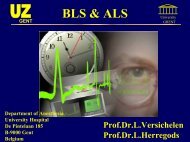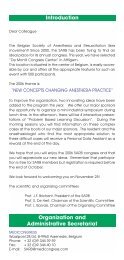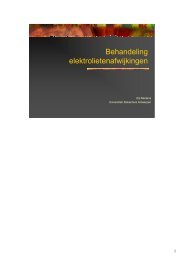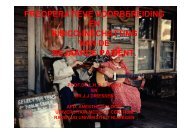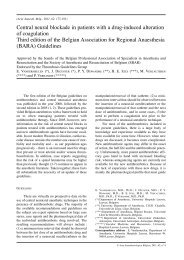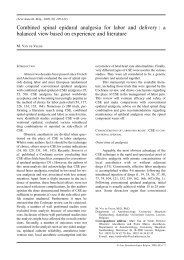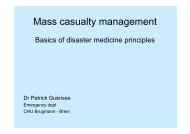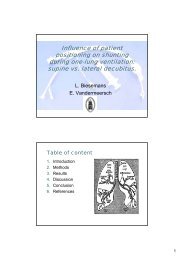BEELDVORMING VOOR DE ANESTHESIST Inleiding
BEELDVORMING VOOR DE ANESTHESIST Inleiding
BEELDVORMING VOOR DE ANESTHESIST Inleiding
You also want an ePaper? Increase the reach of your titles
YUMPU automatically turns print PDFs into web optimized ePapers that Google loves.
<strong>BEELDVORMING</strong> <strong>VOOR</strong> <strong>DE</strong><br />
<strong>ANESTHESIST</strong><br />
L. BIESEMANS<br />
AVU 2008-2009<br />
<strong>Inleiding</strong><br />
• Belang beeldvorming<br />
– Diagnose<br />
– Behandeling<br />
– Follow up<br />
• Wat je ziet is beter dan iedere blinde<br />
techniek, maar niet altijd een toegevoegde<br />
waarde…<br />
– Epiduraal???<br />
– Neuraxiaal???
• Referentiepunten voor centraal veneuze<br />
catheters<br />
– Jugulair<br />
– Subclaviculair<br />
– Femoraal<br />
Eigen zicht<br />
• Conventionele laryngoscoop<br />
– Klassiek beeld in de diepte<br />
• Videolaryngoscoop<br />
Laryngoscopie<br />
– Het einde van de klassieke laryngoscopie in<br />
zicht???<br />
• Glidescope® / Airtraq®<br />
– Enkel in bepaalde gevallen<br />
– Niet altijd eenvoudig toe te passen<br />
– Disposable / kost
Glidescope<br />
Glidescope: characteristics (1)<br />
• Designed to assist airway management by<br />
application of video cameras to a<br />
redesigned classical rigid laryngoscope to<br />
provide an improved view.<br />
• Design is similar to that of conventional<br />
laryngoscope, making it easy for<br />
“conventional laryngoscope users” to use.
Glidescope: characteristics (2)<br />
• Antifogging mechanism<br />
• 60° angle blade provides<br />
– a minimal distorted view of supraglottic anatomy<br />
– access by reducing the need to remove the tongue<br />
from the line of sight to the larynx<br />
• Provides a view of the glottis without alignment<br />
of the oral, pharyngeal and tracheal axes<br />
Glidescope: use<br />
• Placement of endothacheal tubes<br />
• Removal of foreign bodies<br />
• Tube exchanging<br />
• Managing difficult airways<br />
• Positioning of tracheal tubes during<br />
percutaneous tracheostomy
Glidescope: literature (1)<br />
• The Glidescope Video Laryngoscope:<br />
randomized clinical trial in 200 patients.<br />
Sun, British Journal of Anaesthesia 94 (3): 381–4 (2005)<br />
– Conclusion:<br />
• In most patients, the GlideScope provided a laryngoscopic<br />
view equal to or better than that of direct laryngoscopy, but it<br />
took an additional 16 s (average) for tracheal intubation.<br />
• It has potential advantages over standard direct laryngoscopy<br />
for difficult intubations.<br />
Glidescope: literature (2)<br />
• Early clinical experience with a new videolaryngoscope<br />
(GlideScope®) in 728 patients. Cooper, Can J Anesth 2005 /<br />
52: 2 / pp 191–198<br />
• GS laryngoscopy consistently yielded a comparable or<br />
superior glottic view compared with DL despite the limited<br />
or lack of prior experience with the device. Successful<br />
intubation was generally achieved even when DL was<br />
predicted to be moderately or considerably difficult.<br />
• GS was abandoned in 3.7% of patients. This may reflect<br />
the lack of a formal protocol defining failure, limited prior<br />
experience or difficulty manipulating the endotracheal tube<br />
while viewing a monitor.
Glidescope literature (3)<br />
• Case report: “Complications associated with the<br />
use of the Glidescope® videolaryngoscope.”<br />
Cooper, Can J Anesth 54:1 jan 2007<br />
– Perforation palatopharyngeal arch<br />
• R/ suturing / electrocautery<br />
Glidescope literature (4)<br />
• Case report: “Glidescope video laryngoscope is usefuf in<br />
exchanging endotracheal tubes.”<br />
Peral, Anesth Analg 2006;103:1043-1044<br />
– Man, 34j, vocal cord tumor, Malampati 2<br />
– Classic laryngosopy: Cormack 3, ET n° 5,5<br />
– Postoperative<br />
• deterioration of ventilation, ↑ mean inspir. pressure<br />
– R/ Exchanging ET under direct visual control with<br />
Glidescope: larger ET<br />
– Air leak: rupture cuff<br />
• R/ Exchanging ET with airway exchange catheter /<br />
glidescope
Glidescope Literature (5)<br />
• The use of the Glidescope® for tracheal intubation in<br />
patients with ankylosing spondylitis.<br />
Lai, British J Anesth 97 (3): 419-22 (2006)<br />
– Conclusions:<br />
• Glidescope provides a better laryngosopic view<br />
than that of direct laryngoscopy<br />
• Elective patients with ankylosing spondylitis:<br />
– awake fiberoptic intubation is superior: spontaneous<br />
breathing<br />
– Glidescope®: alternative option: general anesthesia<br />
The use of the Glidescope® for tracheal intubation in<br />
patients with ankylosing spondylitis.<br />
Lai, British J Anesth 97 (3): 419-22 (2006)<br />
Pre operative<br />
Malampati<br />
Glidescope<br />
succesful 8/8<br />
Laryngoscopie<br />
Cormack<br />
Glidescope<br />
failure 3/11<br />
Glidescope<br />
succesful 8/11<br />
Glidescope<br />
succesful 1/1
AIRTRAQ®<br />
Airtraq®: advantages<br />
• Provides a magnified angular view of the larynx<br />
and adjacent structures<br />
• No hyperextension of the neck required<br />
• Allows intubation in any position, (e.g., sitting)???<br />
• Easy to use<br />
• Short learning cycle<br />
• Removes potential problems of multi-use<br />
intubation devices???<br />
• Guides the tube (we hope) just before the<br />
entrance to the larynx / no additional separate<br />
manipulation of the tube required
Airtraq®: characteristics (1)<br />
• The Airtraq is an anatomically shaped<br />
laryngoscope with two separate channels:<br />
– Optical channel: contains a high definition<br />
optical system.<br />
– Guiding channel: holds the endotracheal<br />
tube (ETT) and guides it through the vocal<br />
cords.<br />
• It has a built-in Anti-fog system and a low<br />
temperature light.<br />
Airtraq®: characteristics (2)<br />
• It is a very affordable??? SINGLE USE<br />
device: ±80 €<br />
• Set up time between 30-60 seconds<br />
• It can be used with any standard<br />
endotracheal tube
Airtraq®: other applications<br />
• Emergency settings<br />
• Cervical spine immobilization<br />
• Nasal intubations<br />
• Fiberscope Gastroscope guidance<br />
• Double lumen ETT intubation<br />
• Vocal cords visualization<br />
• Foreign body removal<br />
Film Airtraq®
Airtraq ®<br />
Airtraq® Literature (1)<br />
• A comparison of tracheal intubation using<br />
the Aitraq® or the Macintosh laryngoscope<br />
in routine airway management: a<br />
randomised controlled trial.<br />
(Maharaj, Anesthesia, 2006, 61: 1093-1099)<br />
• Randomised controlled trial<br />
– Airtraq (n=30) vs laryngoscope (n=30)<br />
– Only pts at low risk for difficult intubation<br />
– Experienced anesthetists
Airtraq Literature (2)<br />
• All but one pt were succesfully intubated<br />
on the first attempt.<br />
• No difference between groups in duration<br />
of intubation attempts.<br />
• Less alterations in haert rate with airtraq.<br />
• Conclusion: utility of airtraq for tracheal<br />
intubation in low risk patients.<br />
Airtraq® Literature (3)<br />
• Case report: Emergency use of the Airtraq<br />
laryngoscope in traumatic asphyxia.<br />
(Black, Emerg Med J 2007;24:685)<br />
– Bleeding into upper airway<br />
– Rapid sequence intubation with cricoid<br />
pressure prehospital<br />
– Minimal manipulation<br />
• Future???
Fiber (1)<br />
• Intubatie: moeilijke luchtweg<br />
• Onder narcose: spontaan AH/ beademend<br />
• Wakker met sedatie<br />
– Goed lokaal verdoven<br />
» LA spray in de keel / LA thv neus<br />
» Eventueel epidurale catheter door suctiekanaal voor<br />
extra LA in de diepte<br />
Difficult airway
Te verwachten “diffucult airway”<br />
Fiber via nasale route
• Controle positie ET<br />
Fiber (2)<br />
– “gouden standaard” voor plaatsing dubbel<br />
lumen ET<br />
– Ook bij single lumen ET / tracheo<br />
• Vb.: problemen bij beademen, ↑luchtwegdrukken<br />
dr plug, ET op carina, pt. gaat niet bilateraal op,…<br />
• Tracheascheur<br />
• stembandverlamming<br />
Film fiber controle positie<br />
dubbel lumen ET
• Bronchoscopie<br />
Fiber (3)<br />
– Vb. op PAZA na majeure thoracale heelkunde<br />
• Aspiratie secreties<br />
• Controle sutuur bronchiale stomp<br />
• Evaluatie oedeem, roodheid luchtwegen<br />
• Afname sputum / BAL<br />
Casus P.D.<br />
• Vrouw, 61j, thuis onwel geworden, ↓ BWZ<br />
• Bijstand MUG<br />
– GCS: 4/15, extensie bij pijnprikkel, anisocoor<br />
re>li<br />
– Bilat. VAG, sat. 97% met masker 15 l zuurstof<br />
– SR, bradycardie 45/’, BD 201/112 mmHg<br />
– R/ sedatie en curarisatie voor intubatie<br />
– Tijdens transport: bradycardie tot 25/’<br />
– Dringende CT schedel
CT hersenen<br />
Massieve intraventiculaire bloeding, basilaris -<br />
aneurysma? Transtentoriële inklemming<br />
• Consult NCH<br />
CASUS P.D.<br />
– Anisocoor (re>li), niet reactief<br />
– Afwezige hogere stamreflexen<br />
– Intacte lagere stamreflexen (reactie op ET)<br />
– Endorotatie op pijn<br />
– Plaatsen bilat. VED met drukmeting aan 1<br />
kant
RX thorax<br />
Bronchoscopie PAZA
RX na bronchoscopie<br />
Bronchoscopie<br />
• Verwijderen vreemd lichaam<br />
– Rigiede bronchoscoop<br />
• Verwijderen vreemd lichaam onder AA<br />
– Vb.: nootje verwijderen uit luchtweg bij kind<br />
– Flexibele bronchoscoop<br />
• Casus: jongen, 14j., kopspeld ingeslikt…<br />
• Gastroscopie: … niets te vinden<br />
• RX thorax toont vreemd voorwerp
Film casus verwijderen<br />
kopspeld uit luchtweg kind<br />
RX / scopie<br />
• Plaatsen dubbel lumen ET<br />
• Rewiring CVC<br />
• Plaatsen PICC’s (controle positie guide wire)<br />
• Diagnostiek:<br />
• Controle atelectase na “one lung ventilation”<br />
• Positie CVC / uitsluiten pneumothorax na CVC
Dubbel lumen ET: plaatsing<br />
Controle: linker diafragma
Controle: rechter diafragma<br />
Pneumothorax na punctie CVC
Casus S.J.<br />
• Man, 81j, 71kg<br />
• 1° AA voor CABG voor drietakslijden<br />
• Medische antecedenten<br />
– Tabagisme (rookstop 25j)<br />
– Hypercholesterolemie<br />
– Polyneuropathie OL<br />
Casus SJ<br />
• Inductie<br />
– Vasculair acces voor inductie:14G IV / 20G art<br />
– Sufentanil 50µg / midazolam 6mg / etomimidate 20mg /<br />
cisatracurium 20mg<br />
• Vlotte plaatsing ET en beademing<br />
• Verder oplijnen<br />
– 3-L CVC via li v.jug.int.: vlot<br />
– Thermodilutie via re v.jug.int.<br />
• Vlotte punctie<br />
• Catheter schuift moeilijk op<br />
• Blijvend ventriculaire curve: opgeschoven tot 60cm!!!<br />
• Uiteindelijk weerstand bij terugtrekken van catheter
Wat nu gedaan???<br />
Beeldvorming!!!<br />
Scopie peroperatoir
Casus S.J.<br />
• Poging tot “ontknoping”<br />
– Verhogen rigiditeit catheter d.m.v. koude<br />
infusievloeistof<br />
– Guidewire opschuiven door catheter<br />
→ geen succes<br />
– Chirugische verwijdering catheter via<br />
sternotomie<br />
• Tachy-aritmie bij plaatsen klem op hartoortje<br />
– Beta-blokkade, defibrillatie<br />
– ST-afwijkingen<br />
RX: diagnostiek
Echo (1)<br />
• Regionale Anesthesie: peri,… cfr. infra<br />
• Vasculaire acces (cfr. Les AVU: perifere<br />
echo)<br />
–CVC<br />
– PICC’S<br />
– (art.)<br />
• Perifeer zenuwblock (cfr. Les AVU:<br />
zenuwblocks)
Echo (2)<br />
• Cardiac imaging (3-D)<br />
– Inschatten cardiale functie tijdens cardiale<br />
heelkunde<br />
• Contractiliteit, RWMA,…<br />
• Status kleppen<br />
– Stenose<br />
– Insuffuciëntie<br />
– Diagnostiek: uitsluiten tamponade, enz. …<br />
– Optimalisatie vullingsstatus
echocardio<br />
Echo (3)<br />
• Heartport: Mitral valve<br />
• Echocardio:<br />
– Uitsluiten contraindicaties:<br />
• AI en/of “zieke Ao” → cardioplegie in ventrikel i.p.v. in<br />
coronairen: geen bescherming hart<br />
– 1° veneuze canule: v. jug. int. dr ane<br />
• Controle positie / heparinisatie<br />
– 2° veneuze canule: v. femoralis dr chirurg<br />
• Controle positie: VCI, begin atrium<br />
– Arteriële canule: a. femoralis dr chirug<br />
• Controle positie seldinger in arterie<br />
• Uitsluiten dissectie<br />
• Controle positie ballon<br />
– 3 cm boven AoK en onder tr.brachioceph. re<br />
• Insufflatie ballon: vervangt AoX
• Transthoracaal<br />
Echo (4)<br />
– Uitsluiten pneumothorax<br />
– Evaluatie pleurauitstorting<br />
• bladderscan<br />
Literatuur echo (1)<br />
• Britisch Journal of Anaethesia, vol 94,<br />
Number 1, jan 2005, Editorial 1<br />
– Location, location, location! Ultrasound<br />
imaging in regional anaesthesia<br />
• Ultrasound imaging in pediatric regional<br />
anesthesia, Rapp, Canadian Journal of An 51: 277-278<br />
(2004)
Literatuur echo (2)<br />
• Ultrasound imaging improves learning curves in obstetric<br />
epidural anesthesia: a preliminary study.<br />
Grau, Canadian J of ane 50: 1047-1050 (2003)<br />
– Purpose:<br />
• evaluate teaching possibilities of US as a diagnostic<br />
approach to the epidural region<br />
– Methods<br />
• 2 groups of residents performed their first 60<br />
obstetric epidurals under supervision<br />
• Control group (CG): LOR technique<br />
• Ultrasound group (UG): Prepuncture US followed by<br />
LOR<br />
Literatuur echo (3)<br />
• Results: success rate<br />
–CG:<br />
• 60%±16%: peri 1 to 10<br />
• 84%: peri 11 to 50<br />
–UG:<br />
• 86%±15%: peri 1 to 10<br />
• 94%: peri 11 to 50<br />
• Prepuncture ultrasound<br />
– Location optimal puncture point<br />
–Depth<br />
– angle
Monitoring<br />
• Oesophagale doppler<br />
– Flow Aorta<br />
– Volume optimalisatie bij majeure gastrointestinale<br />
heelkunde<br />
Anesthesia Record Saving
Anesthesia Record Saving
Anesthesia Record Saving<br />
Anesthesia Record saving



